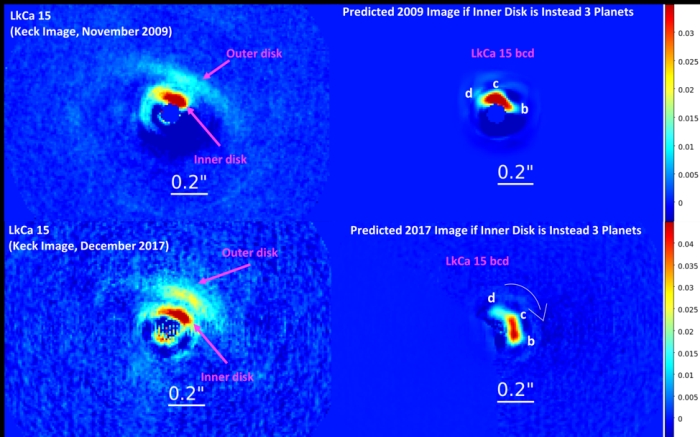Key Takeaways:
- Powerful telescopes in Hawaii provided unprecedented images of a young star system, revealing details about its dusty birthplace.
- Previously thought-to-be giant planets were actually a misinterpretation of the disc’s light. This highlights the need for more refined detection methods.
- The lack of confirmed giant planets doesn’t mean no planets are forming. Smaller ones might still be there.
- Studying these young planets could provide crucial insights into how planets form, including those in our own Solar System.
- The hunt for planets within this system is far from over. Future observations might reveal our cosmic neighbours.
Astronomers in Hawaii have achieved a breakthrough using a powerful duo of telescopes. Their gaze pierced the veil surrounding a young star, LkCa 15, located a staggering 473 light-years away. This newfound clarity revealed a protoplanetary disc – a swirling birth chamber where planets are still in their formative stages.
While previous observations hinted at the presence of three massive planets, these latest findings cast doubt on that claim. The good news is, this doesn’t signify a lack of planetary formation. Instead, it highlights a crucial refinement in detection techniques. This advancement paves the way for a more nuanced understanding of how planets come to be.
Imagine a celestial nursery. Newborn stars are nestled within a swirling disc of gas, dust, and rocky debris. Over time, these particles clump together in a process known as planetary accretion. Gravity takes center stage, attracting more and more material until a fully formed planet emerges, clearing its orbital path in the process.
Spectacular images of these protoplanetary discs, showcasing the telltale signs of material clearing, have been captured before. In fact, astronomers previously believed they had spotted three colossal planets, each dwarfing our own Jupiter, orbiting LkCa 15 within a vast gap resembling our Solar System. This detection relied on a technique known as sparse aperture masking interferometry, designed to separate the faint light of planets from the overpowering glow of their host star.
However, by combining the might of the Subaru Telescope and the W. M. Keck Observatory, a global team of researchers has unveiled a surprising twist. The light previously attributed to planets actually originated from the disc itself!

“The complexity of LkCa 15 is truly remarkable,” remarked Dr. Thayne Currie, an astrophysicist affiliated with NASA-Ames Research Center and the Subaru Telescope. “Before analyzing the data from Keck and Subaru, based solely on earlier observations, we too would have concluded there were three super-Jupiter planets.”
This latest investigation was meticulous. The Subaru Telescope’s cutting-edge instrument, the Subaru Coronagraphic Extreme Adaptive Optics (SCExAO), teamed up with the Coronagraphic High Angular Resolution Imaging Spectrograph (CHARIS) to capture near-infrared images of the disc. Meanwhile, the W. M. Keck Observatory’s Near-Infrared Camera (NIRC2) observed the system at longer wavelengths, optimal for detecting young planets. Additionally, the team unearthed archival NIRC2 images of the system captured in 2009, providing valuable data points for comparison.
The combined analysis, encompassing both new and archived data, revealed a key detail. The majority of the light emanating from LkCa 15 stemmed from the disc’s prominent, arc-shaped edge. This edge’s brightness had previously been misinterpreted as the signature of colossal planets.
However, the absence of confirmed giant planets doesn’t preclude the existence of planetary bodies altogether. The research team believes that smaller, less luminous planets, perhaps akin to Jupiter or Saturn in size, could still be nestled within the disc. If successfully detected, these planets could hold the key to unlocking the secrets of planetary formation, not just on a universal scale, but specifically in the context of our own Solar System.
“The planets in this nascent solar system might bear a closer resemblance to our own than previously thought,” Dr. Currie concluded. “They’re most likely out there, potentially veiled within the disc. The search continues.”


